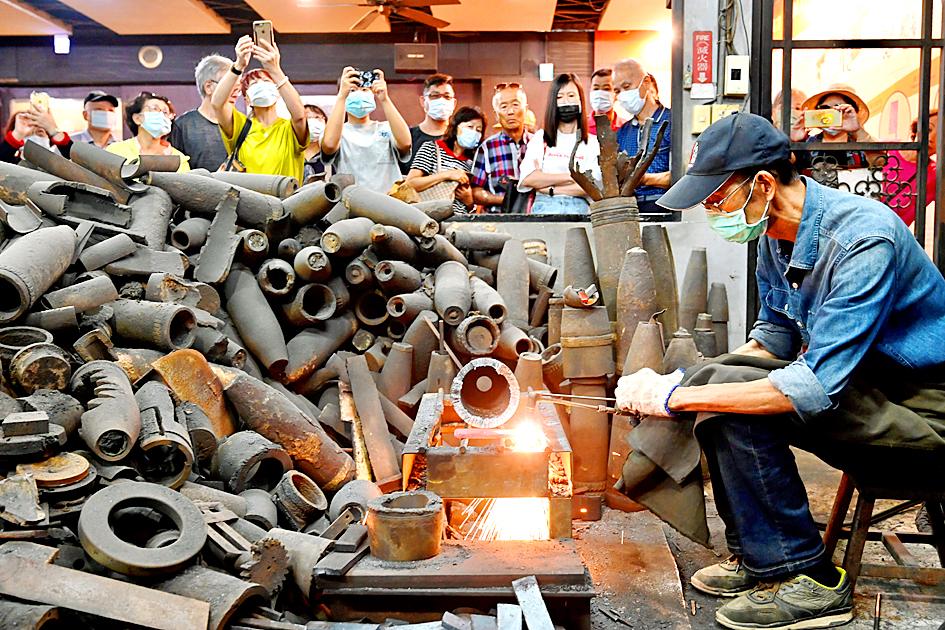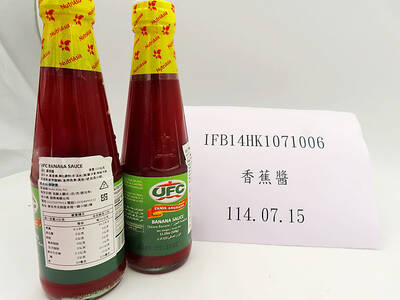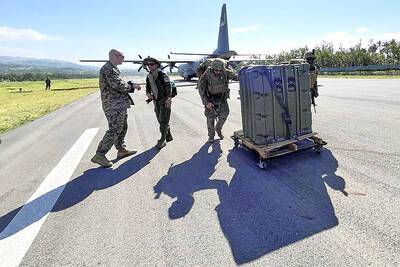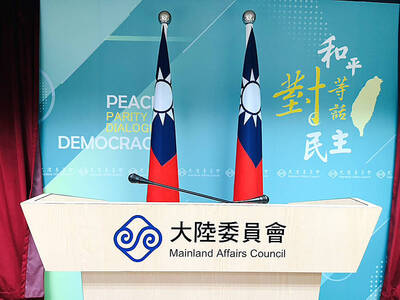In a contemporary twist on beating swords into plowshares, blacksmith Wu Tseng-dong (吳增棟) has forged a career fashioning kitchen knives from Chinese artillery shells once fired at his home.
Known locally as “Maestro Wu,” his workshop on Kinmen — just 3km from China — is a vivid reminder of the threat of war continually hanging over Taiwan.
Like many of the older people living on Kinmen, Wu grew up under bombardment.

Photo Sam Yeh, AFP
Even after the Chinese Civil War ended in 1949, leaving Mao Zedong’s (毛澤東) Chinese Communist Party in charge of China and Chiang Kai-shek’s (蔣介石) Chinese Nationalist Party (KMT) in Taiwan, Kinmen continued to be shelled by Mao’s forces.
Wu was born shortly before the worst bombardment in 1958, when nearly half a million shells were fired at Kinmen and other nearby islets over a 44-day period, killing 618 and injuring more than 2,600.
The shells were still falling as late as the 1970s, although by then they were packed with propaganda leaflets rather than explosives.
Wu has vivid childhood memories of hiding in air-raid shelters with his family at night, while scavenging metal fragments by day for scrap.
“I remember the fear we felt at night,” Wu said. “Shelling may look exciting in the movies the more intense it gets, but in reality it’s very dangerous.”
“We tried to pick up as many shells as we could, even climbing the trees to get them, to exchange them for little prizes. It was fun for our childhood, even though we feared the air raids,” he said.
A third-generation blacksmith, Wu learned how to mold metal as a young boy. He followed in the footsteps of his father, who first started turning shells into knives when some Taiwanese soldiers stationed on Kinmen began asking for custom orders.
Most of Wu’s knives are made from the cases of the propaganda shells, which are better preserved, as they did not explode on impact. In the past three decades he estimates that he has bashed out about 400,000 knives.
The old shells are stacked high in Wu’s workshop, which has become something of a draw for tourists. Visitors excitedly snap pictures as Wu methodically sculpts a glowing hunk of metal into a cleaver.
Kinmen had become a popular destination for tourists from China — at least until the COVID-19 pandemic shut the nation’s borders.
Direct transportation links were launched in 2008 when ties were warmer, but cross-strait relations have chilled after the election of President Tsai Ing-wen (蔡英文) of the Democratic Progressive Party in 2016.
Chinese jets have begun crossing into Taiwan’s air defense identification zone at an unprecedented rate and Wu said that he feels tensions are now at their highest — probably even more than in the mid-1990s when China fired ballistic missiles into the Taiwan Strait in a bid to deter the nation’s first direct presidential election.
China’s threats are something Taiwanese have long had to live with, but Wu says many of those in Kinmen know first-hand what conflict looks like and never want to see it return.
“The people don’t want war,” he said. “It’s very brutal and we in Kinmen experienced it during the 823 Artillery Bombardment [in 1958], having relatives and friends killed or injured.”
“I hope the two sides can deal with each other peacefully... It is up to the wisdom of both governments,” he said.

Three batches of banana sauce imported from the Philippines were intercepted at the border after they were found to contain the banned industrial dye Orange G, the Food and Drug Administration (FDA) said yesterday. From today through Sept. 2 next year, all seasoning sauces from the Philippines are to be subject to the FDA’s strictest border inspection, meaning 100 percent testing for illegal dyes before entry is allowed, it said in a statement. Orange G is an industrial coloring agent that is not permitted for food use in Taiwan or internationally, said Cheng Wei-chih (鄭維智), head of the FDA’s Northern Center for

LOOKING NORTH: The base would enhance the military’s awareness of activities in the Bashi Channel, which China Coast Guard ships have been frequenting, an expert said The Philippine Navy on Thursday last week inaugurated a forward operating base in the country’s northern most province of Batanes, which at 185km from Taiwan would be strategically important in a military conflict in the Taiwan Strait. The Philippine Daily Inquirer quoted Northern Luzon Command Commander Lieutenant General Fernyl Buca as saying that the base in Mahatao would bolster the country’s northern defenses and response capabilities. The base is also a response to the “irregular presence this month of armed” of China Coast Guard vessels frequenting the Bashi Channel in the Luzon Strait just south of Taiwan, the paper reported, citing a

UNDER PRESSURE: The report cited numerous events that have happened this year to show increased coercion from China, such as military drills and legal threats The Chinese Communist Party (CCP) aims to reinforce its “one China” principle and the idea that Taiwan belongs to the People’s Republic of China by hosting celebratory events this year for the 80th anniversary of the end of World War II, the “retrocession” of Taiwan and the establishment of the UN, the Mainland Affairs Council (MAC) said in its latest report to the Legislative Yuan. Taking advantage of the significant anniversaries, Chinese officials are attempting to assert China’s sovereignty over Taiwan through interviews with international news media and cross-strait exchange events, the report said. Beijing intends to reinforce its “one China” principle

A total lunar eclipse, an astronomical event often referred to as a “blood moon,” would be visible to sky watchers in Taiwan starting just before midnight on Sunday night, the Taipei Astronomical Museum said. The phenomenon is also called “blood moon” due to the reddish-orange hue it takes on as the Earth passes directly between the sun and the moon, completely blocking direct sunlight from reaching the lunar surface. The only light is refracted by the Earth’s atmosphere, and its red wavelengths are bent toward the moon, illuminating it in a dramatic crimson light. Describing the event as the most important astronomical phenomenon